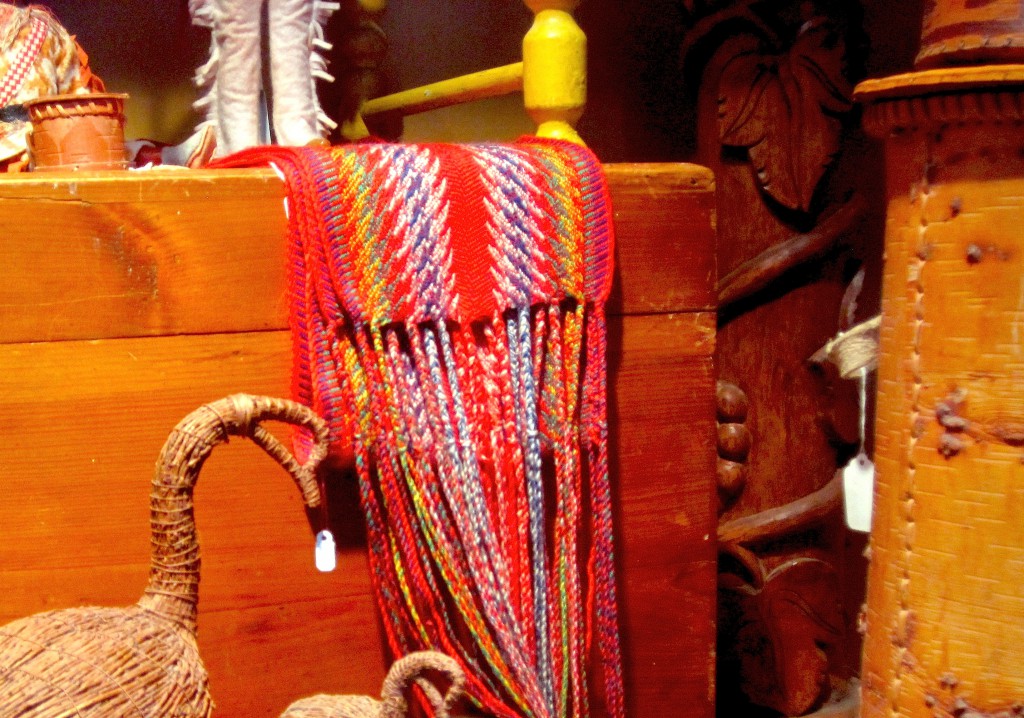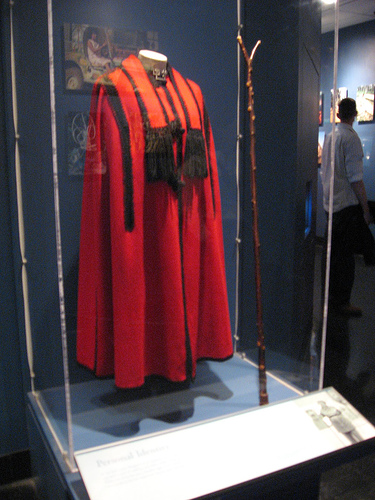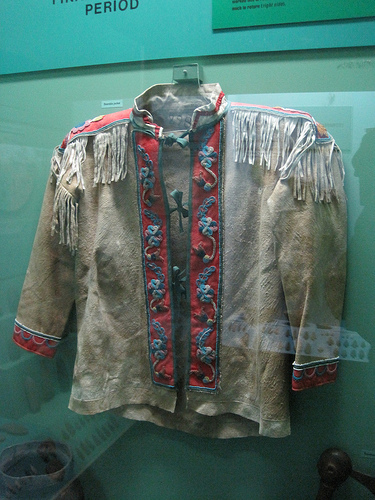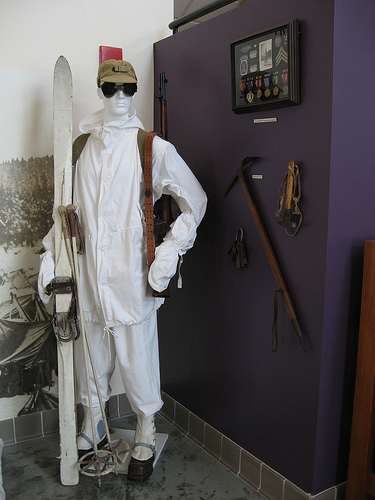Savage Minds welcomes guest blogger Matthew Timothy Bradley.
One of the things I want to do during my second go-round guest blogging at Savage Minds is to create a series of how-to posts—what is called “service writing” in the commercial publishing world—about dressing for hot weather fieldwork. Prior to that, though, I want to offer this list of seven of my favorite academic articles about clothing. The list is meant to be fun, as are the photos and the video of mine I have included along with it, none of which are meant to be illustrative of the items discussed in the articles. Please do feel free to mention some of your own favorite clothing-related articles, books, broadcasts, or films in the Comments, as well as to link to any photos or videos of your own. (Seriously! Please do. ☺)

It is my educated guess that cultural anthropologists are professionalized to look for “meaning” in their research topics and to give a fairly theoretical angle to their written material. In addition, most graduate programs in cultural anthropology require minimal training in the nuts and bolts of historiography or in the formal analysis of material culture. When a cultural anthropologist tells me they do material culture, my prejudice is to assume that s/he takes a “social life of things” approach to the subject matter. That is certainly an important strand of material culture studies, and one to which cultural anthropologist have made, and continue to make, important contributions in terms of clothing research.
My own personal interest in clothing, though, tends towards issues of history and function. Because of this, authors with a professional background in archaeology, folkloristics, and art history dominate my list.

Bibliography
Becker, Marshall Joseph. “Matchcoats: cultural conservatism and change in one aspect of Native American clothing.” Ethnohistory 52, no. 4 (Fall 2005): 727–87. doi:10.1215/00141801-52-4-727.
One of the reasons I admire Ethnohistory is for its willingness to serve as a venue for long articles like this one that amount to mini-monographs. I am big on this article because it demonstrates that certain lines of research do not happen unless a researcher possesses both a broad skill set and a broad set of interests, and then only after years of having accumulated enough information to have come up with the research question in the first place.

Conn, Richard. “Some design concepts of traditional Subarctic clothing.” Arctic Anthropology 28, no. 1 (January 1991): [84]–91.
The Subarctic has what is probably the widest range of seasonal weather change of any climactic zone. It not only gets bitterly cold in the winter, but also authentically warm during a short summer season. This summer season is accompanied by the appearance of swarms of biting insects who make their homes in the numerous wetlands spread across the Subarctic belt. Conn’s article seeks to identify design features developed as protection against the cold and insects in both North American and Asian Subarctic clothing technology.
Douny, Laurence. “Wild silk textiles of the Dogon of Mali: the production, material efficacy, and cultural significance of sheen.” Textile: The Journal of Cloth and Culture 11, no. 1 (March 2013): 58–77. doi:10.2752/175183513X13588738654891.
“As Dogon women say, cotton dies but wild silk will always remain.” Douny does not utilize the concept of ‘qualisign’ in his article, but it should come immediately to mind for any reader familiar with the term.
[flickr video=4888191384 w=675 h=506.25]
Havenith, George. “Benchmarking functionality of historical cold weather clothing: Robert F. Scott, Roald Amundsen, George Mallory.” Proceedings of the 3rd Textile Bioengineering and Informatics Symposium (2010): 1204–12. doi:10.3993/tbis2010214.
Havenith shows that the textile-based clothing utilized by Scott’s team during their 1911–12 expedition to reach the South Pole offered a poorer insulation to mass ratio than did Amundsen’s team’s Inuit-style skin clothing. (This would have meant something on a multi-day trip in the Cairngorms, but during a multi-week expedition in Antarctica it meant something else, indeed.) I value this article for making me aware of how long it took the rest of the world to catch up to the centuries-old clothing cold weather clothing technology of the Inuit.

Jackson, Jason Baird. “Dressing for the dance.” Ch. 8 in Yuchi folklore: cultural expression in a Southeastern Native American community. Vol. 272 in Civilization of the American Indian. Norman: University of Oklahoma Press, 2013. OCLC = 843010506.
Fruitfully paired with the podcast that is accessible here, Jason’s article, originally published in American Indian Art Magazine, gives a formal presentation of contemporary Yuchi ceremonial dress via prose description and illustrative examples. As with Becker’s article, a familiarity with multiple sources of data (including museum collections and the documentary record, both written and illustrated) and with comparative ethnology allow Jason to make observations on historical trends in Yuchi clothing, such as the fact that contemporary Yuchi national dress is drawn from the everyday wear of the past.
Kingsley, Bonnie M. “The cap that survived Alexander.” American Journal of Archaeology 85, no. 1 (January 1981): 39–46. doi:10.2307/504964.
Kingsley convincingly shows how the ancestral version of the kausia worn in contemporary Macedonia arrived there with troops who had campaigned with Alexander in modern day Afghanistan. Kingsley’s research on the topic began after seeing “photographs [of pakols] transmitted by laser and satellite to the outside world” during the initial years of the Soviet intervention in Afghanistan.
McNaughton, Patrick R. “The shirts that Mande hunters wear.” African Arts 15, no. 3 (May 1982): 54–58, 91. url:http://hdl.handle.net/2022/3289. doi:10.2307/3335912.
I find hunters’ shirts breathtaking and more than a little frightening. While there is nothing quite like being in the presence of one—it is a multisensory experience—McNaughton’s article is a good place to start.
Hey there! Thank you for bringing up this interesting topic. However, for some reason, the descriptions of the articles on the list are written in a very small font and they’re a bit hard to read.
I find “Clothing as Material Culture” (ed. Susanne Küchler, Daniel Miller) to be worthwhile. The main idea behind articles featured in this book is to combine the “social life of things” approach with the one that you prefer and that is traditionally associated with art history or archaeology. I would recommend this book to anybody who is interested in clothing and materiality. It might give you food for thought.
I also like “Clothing. A Global History” by Robert Ross. Even though it definitely represents the more “social” strand within the studies of clothing, I remember I enjoyed reading it a few years ago. Ross analyzes the relationship between dress and imperialism in a very entrancing, accessible way.
Thanks for the feedback, Jagna! I used a smaller font size to set the annotations apart from the references. I’ve reformatted the annotations (changed the font size back to the norm and increased the margins to set them off), maybe that will be more readable.
Both of the readings sound great, I will give them a look first chance I get!
The little 4 page section on “The Sari” in Daniel Miller’s “Stuff” is a brilliant little miniature of a piece. I’ve never read the book on the Sari he co-wrote, though. Michael O’Hanlon’s “Reading the Skin” is an old favorite.
The O’Hanlon book sounds good. I remember reading a slightly cutting review of the sari book by a female Indian academic a couple of years ago that wasn’t uncomplimentary, but did say that the authors found more than was there (the review said something along the lines of, “But as the Americans say, ‘Oh, come on!’”). It sounds like maybe the four page section boils down the best from that research, so I will definitely check it out.